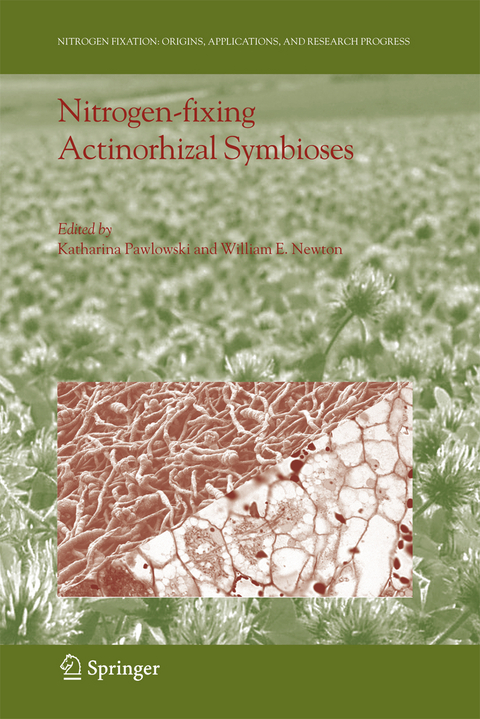
Nitrogen-fixing Actinorhizal Symbioses
Springer (Verlag)
978-90-481-6895-8 (ISBN)
Preface to the Series, Preface, List of Contributors, Dedication.
1. Frankia and Actinorhizal Plants: A Historical Perspective: C. T. Wheeler, A. D. L. Akkermans, and A. M. Berry
1. Introduction
2. The Early Years
3. Two Decades to the New Millennium
4. Perspectives
References
2. Polyphasic Taxonomy of the Genus Frankia: D. Hahn
1. Introduction
2. Polyphasic Taxonomy Approach
3. 16S-rRNA Sequence Data
4. DNA-DNA Relatedness
5. 23S-rRNA Sequence Data
6. Genomic Fingerprinting
7. Conclusions
References
3. Frankia Ecology: M. Valdés
1. Introduction
2. Frankia as a Soil Microorganism
3. Abiotic Soil Factors and Frankia Populations
4. Biotic Soil Factors: Mycorrhizal Fungi and Frankia
5. Conclusions References
4. Evolution of Actinorhizal Host Plants and Frankia Endosymbionts: S. M. Swensen and D. R. Benson
1. Introduction
2. Host-Plant Systematics and Phylogeny
3. Frankia Phylogeny and Evolution
4. Host-Frankia Interactions and Evolution
5. Future Directions
References
5. Oxygen Responses, Hemoglobin, and the Structure and Function of Vesicles: W. B. Silvester, R. H. Berg, C.R. Schwintzer and J. D. Tjepkema
1. Introduction
2. Vesicle Structure and Oxygen Responses of Frankia in vitro
3. Responses in Symbiosis
4. Hemoglobins in Actinorhizal Nodules and Frankia
5. Concluding Discussion
References
6. Early Interactions, Infection and Nodulation in Actinorhizal Symbiosis: L. G. Wall and A. M. Berry
1. Introduction
2. Early Interactions
3. Rhizosphere Colonization
4. Root Infection by Frankia
5. Nodule Development
6. Regulation of Nodulation
References
7. Carbon and Nitrogen Metabolism in ActinorhizalNodules: C. Valverde and K. Huss-Danell
1. Introduction
2. The Actinorhizal Nodule
3. Studying C and N Metabolism of Nodules
4. Carbon Supply to Nodules
5. Carbon Uptake and Metabolism by Symbiotic Frankia
6. Nitrogen Metabolism
7. The Regulation of N Assimilation
8. ProspectsReferences
8. Ecology of Actinorhizal Plants: J. O. Dawson
1. Importance of Actinorhizal Plants
2. Occurrence and Distribution of Actinorhizal Plant Taxa and their microsymbionts
3. Ecological Factors Influencing Infective Frankia Populations
4. Ecological of Actinorhizal Plants
References
9. Molecular Biology of Actinorhizal Symbioses: L. Laplaze, S. Svistoonoff, C. Santi, F, Auguy, C. Franche and D. Bogusz
1. Introduction
2. Infection Process
3. Nodule Development
4. Nodule Functioning
5. Evolutionary Origin of Symbiotic Genes
6. Future Trends
7. Conclusions
References
10. Comparison between Actinorhizal and Legume Symbiosis: K. Pawlowski and J. I. Sprent
1. Introduction
2. Nodule Structure
3. Nodule-Induction Mechanisms
4. Host Specificity
5. Root Nodules and Other Root Symbioses
6. Evolution of Root-Nodule Symbioses
References
11. Prospects for the Study of a Ubiquitous Actinomycete, Frankia, and Its Host Plants: P. Normand and B. C. Mullin
1. Introduction
2. Development and Use of Molecular Tools for Genetic Analysis of Symbiosis
3. Prospects for Future Utilization of Actinorhizal Plants
4. Questions Still to be Addressed
5. Prospects for Extending Symbioses beyond Current Host Range
6. Conclusions
References
Subject Index
| Erscheint lt. Verlag | 19.11.2010 |
|---|---|
| Reihe/Serie | Nitrogen Fixation: Origins, Applications, and Research Progress ; 6 |
| Zusatzinfo | XX, 312 p. |
| Verlagsort | Dordrecht |
| Sprache | englisch |
| Maße | 155 x 235 mm |
| Themenwelt | Naturwissenschaften ► Biologie ► Biochemie |
| Naturwissenschaften ► Biologie ► Botanik | |
| Weitere Fachgebiete ► Land- / Forstwirtschaft / Fischerei | |
| ISBN-10 | 90-481-6895-3 / 9048168953 |
| ISBN-13 | 978-90-481-6895-8 / 9789048168958 |
| Zustand | Neuware |
| Haben Sie eine Frage zum Produkt? |
aus dem Bereich


